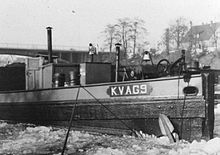Goering-Kahn
The name Göring-Kahn or Schwedenkahn appears in Germany during and after the Second World War . The colloquial term among inland navigation operators is a series of wooden barges that were built in Uddevalla ( Sweden ) at the beginning of the 1940s for the so-called Reichswerke AG for inland navigation "Hermann Göring", or Göring-Werke for short . They were assigned to the Kanal-Verkehr AG, founded on April 25, 1942 in Berlin - with headquarters in Braunschweig and a branch in Ruhrort. Under this generic term, the Reich owned or the Reich participations in inland shipping companies and shipyards were summarized.
Design and special features
Unfortunately, no drawings or construction documents of these boats have survived at the moment. From statements by boatmen and shipbuilders and from what is presumably the last remaining wreck in the Havel near Hennigsdorf (Brandenburg), an unusually complex and robust wooden construction can be inferred. The side walls are partially planked diagonally and bolted with a particularly large number of nails. The loading floor (strau) was laid as parquet floor. Later, the bow area outboard was provided with iron plates because of possible ice drifts in the canal. According to the current state of knowledge, ten wooden barges of the same design have been built in Sweden. Five of these boats were lost in World War II . Kanal-Verkehr-AG Duisburg-Ruhrort (KVAG), a foundation of Hermann-Göring-Werke AG, later Salzgitter AG , had four ships in service until 1950 with the registrations SK KVAG 3/5/7 and 9 . A boat was motorized and ran under the name Lux with home port Dortmund . The dimensions of about 55 meters in length, 8.2 meters in width and 550 to 600 tons load-bearing capacity can be derived from memories of inland waterway operators, register lists and the wreck itself shown in the photo.
history
The generic term Göring-Kahn is not just a construction type, but a summarizing generic term for those ships that were in service in the service of the Reich waterway offices and later in the war years were assigned to the Reich Labor Service as work, construction and supply barges . Thus the designation Göring-Kähne cannot be clearly assigned to a type of construction. The term Göring-Kahn solidified and established itself especially in the inland waterway fleet that was being rebuilt after the war, especially in the Soviet Zone , later the GDR , and denoted work ships that came from the ownership of Reichswerke AG and after 1945 on the territory of the Soviet occupation zone remained. These ships were expropriated and confiscated. Parts of this fleet of ships were directly subordinated to the Soviet military, called the Red Fleet , the rest was handed over to the Inland Shipping Working Group, then called the Green Fleet , by order No. 29 of the SMAD . The terms Red and Green Fleet originated from the color of the newly issued ship pass.
The initially colloquial term Göring-Kahn was first officially used when the inland waterway fleet was reorganized and re-registered in the then Soviet occupation zone of Germany at the General Directorate Shipping (abbreviated GDS ) / Department S I around July 7, 1947 to determine the ship pass numbers for the Green Fleet and the Assignment of the work ships used for the technical fleet. The Göring barges were mainly assigned to the technical fleet and assigned to the waterway authorities.
Explanation of the photos
The barge shown in the photos was used after 1945 to clear Berlin of rubble and was then assigned to the waterway authorities as a work ship of the technical fleet in the course of the re-establishment of the inland waterway fleet. The ship pass number assigned to the ship could not yet be determined despite extensive research. The ship comes from the fleet of the waterways main office Berlin (East). In the course of securing the sector borders and the GDR national territory, a checkpoint was created in Hennigsdorf for cross-sector and cross-border inland shipping. This was created at the junction of the Oder-Havel Canal to the Havel Canal in the direction of Potsdam on the one hand, and in the direction of Berlin-West on the other. In order to achieve a forced canalization, several work barges , which came from the takeover stocks of the Göring barges, were sunk in the neighboring lake area in the direction of Berlin-West in Nieder Neuendorfer See and built into an artificial pier using rubble and earth filling. Therefore, these ships lying there are colloquially known as pier barges .
Coordinates
The coordinates show the position of the wooden barge shown in the photo in the area of the former border crossing point in the Havel-Oder-Wasserstraße directly at the junction of the Havel Canal between the GDR and West Berlin.
literature
- S. Zesewitz, Th. Grötschel: Forced Labor in German Inland Shipping 1940–1945 . In: Navalis. 1/06, Berlin 2006, p. 19, knoll maritim Verlag, ISSN 1613-3846
Web links
- Photos of the barges in the Niederneuendorfer See , accessed on February 24, 2018.
Individual evidence
- ↑ Description of the barges by a former inland boatman in the Inland Navigation Forum
- ↑ HW. Thin, H-Ch. Knoll: 50 years of the German inland shipping company . Koehlers Verlagsgesellschaft, Hamburg 1999, ISBN 3-7822-0757-2 . Order of the Soviet Military Administration p. 13 ff.
- ↑ Explanation on ship registration in the GDR
Coordinates: 52 ° 37 ′ 3 " N , 13 ° 12 ′ 41.3" E



